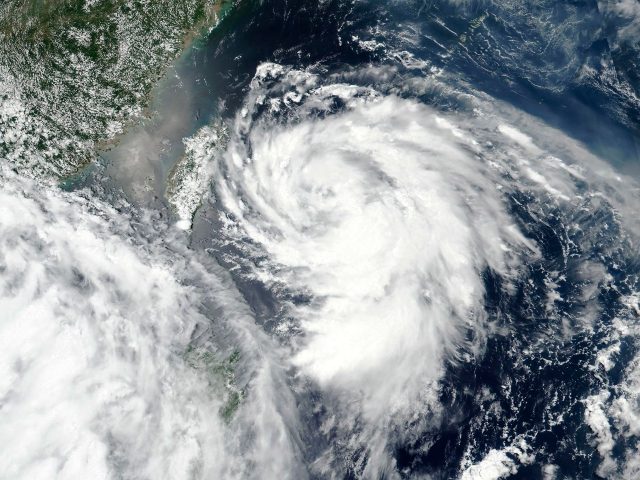Flood-ravaged areas of China faced a new threat on Monday as Typhoon Hagupit approached its eastern coast, bringing 55-mile-per-hour wind gusts and more heavy rain.
The previous typhoon, Sinlaku, is still bringing heavy rainfall to parts of China, while unnamed storms continue popping up across flooded provinces.
Hagupit, the fourth typhoon of the season, is expected to make landfall somewhere between Zhejiang and Fujian provinces on Monday night, bringing gale-force winds and two days of heavy downpours. Guangdong and Hainan provinces are expected to take up to 13 inches of rain from the departing Typhoon Sinlaku. Meteorologists predict torrential rains across several other provinces, including the Chinese capital city of Beijing, prompting emergency flood control warnings in numerous districts already struggling to contain swollen rivers.
Chinese Premier Li Kequiang on Friday called for “relentless efforts” at flood control, including the protection of key industries. Hundreds of patients of all ages have been evacuated to higher ground from flooded hospitals. Individual cities report relocating tens of thousands of people to temporary shelters as floodwaters rise.
Taiwan News reported on the hard-hit city of Xi’an had been raised to China’s highest level of rain and flood warning several times over the past week. While Chinese state media tried to spin the disaster by comparing the rain to a religious baptism and posting photos of the rainbows forming over the city as the clouds parted, Taiwan News reported the city and many of its downstream suburbs have been all but wiped out by floods, and some of the residents are not happy about the Communist Party attempting to paint a smile over their suffering:
The Associated Press (AP) reported widespread evacuation orders along the east coast of China on Monday, with transportation services suspended and boats recalled to port ahead of Typhoon Hagupit’s arrival. Fishing, tourism, and construction activities have been temporarily suspended.
The AP pointed out that this year’s typhoon season has been “relatively mild” by historical standards, but the intense rainfall and flooding have inflicted over $7 billion in damage despite the modest size and number of named storms.
Writing at the Maritime Executive on Sunday, Dr. Peter McCawley of Australian National University’s Arndt-Corden Department of Economics saw the fresh barrels of rain headed for China as the next chapter in the “major test” faced by the massive Three Gorges Dam – the focus of much nervous attention from those living beneath it, and possibly the point of stress that could fracture the entire Chinese Communist regime if it fails:
The latest crisis within China is dangerous flooding along the Yangtze River, which is testing the design of the huge Three Gorges Dam. Completed in 2006, the dam is one of the world’s largest megaprojects. The structure lies about 300 kilometres west of Wuhan, the metropolis of close to 20 million people where the novel coronavirus first broke out. The threats arising from the flooding have led to the evacuation of about 40 million people.
Safety issues concerning the Three Gorges Dam reflect long-standing international debates about infrastructure, and especially dams, in developing countries. Large dam projects are almost always controversial.
In McCawley’s analysis, the immense scale of the Three Gorges Dam makes it the biggest example of everything that can go wrong with such projects, from environmental disruption and population displacement to corruption and social costs.
The dam hopefully is not at risk of catastrophic structural failure, but its presence could be doing at least as much harm as good for flood control, particularly if the dam operators are obliged to continue venting huge amounts of floodwater into lower-lying regions with little warning. Also, the hydroelectric plant at Three Gorges supplies a great deal of electric power to meet China’s growing needs, so there could be serious social, political, and economic consequences if the plant is forced to shut down or reduce capacity substantially.
“The Three Gorges Dam has been a major showcase project for China. China’s proud reputation as a global supplier of high-quality infrastructure is now at stake, as the reliability of the Three Gorges Dam is being put to the test,” McCawley concluded.
CNN noted on Friday that while the Chinese government still presents the Three Gorges Dam as an unmitigated triumph from every possible standpoint, “some geologists say the limited role of the Three Gorges dam in flood control has been laid bare” by the current crisis.
Some areas downstream of Three Gorges are reporting the worst floods in modern history despite the presence of the gigantic dam, leading analysts to conclude the structure is mostly helpful for flood control during modest flood years but could be a net liability during severe seasons like the current one. The dam causes erosion of the surrounding hills, triggering landslides and worse flooding in tributaries of the Yangtze River, and the immense weight of its reservoir might even be causing more earthquakes in the region. Meanwhile, those displaced by the construction of the dam are still suffering the economic effects decades later, including reduced earning potential.
As one geologist put it: “It’s like using a small cup to deal with a big tub of water. In terms of flood control, the cost of the dam has surely outweighed the gain.”

COMMENTS
Please let us know if you're having issues with commenting.